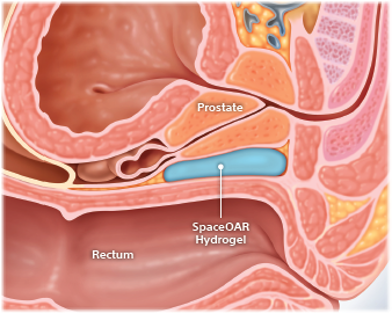Radiotherapy researchers leading the way with first commercial device trial
15 January 2024
A new research trial opened recently marks the first commercial medical device trial lead by the Radiotherapy Research team at Velindre Cancer Centre.
The SABRE trial involves the use of the SpaceOAR Vue system designed by Boston Scientific in patients being treated with radiotherapy for prostate cancer.
Radiation therapy is extremely effective in targeting and treating prostate cancer. Side effects can be mild and go away on their own but for some patients they can last for years after treatment and can impact on quality of life.
Velindre is one of only two centres in the UK taking part in this trial which combines the use of the spacer with a five fraction regime of radiotherapy, something the radiotherapy service has experience in.
This is exciting because we don’t see many commercial trials in radiography, and this is our first trial of a commercial medical device.
Matthew Lazarus, Senior Research Radiographer at Velindre Cancer Centre, said:
 “Prostate cancer is very treatable, but the treatment can have lasting side effects including diarrhoea, constipation and damage to the rectal wall. The spacer is designed to reduce the long term side effects from radiotherapy to the rectum.
“Prostate cancer is very treatable, but the treatment can have lasting side effects including diarrhoea, constipation and damage to the rectal wall. The spacer is designed to reduce the long term side effects from radiotherapy to the rectum.
“Interest in the study from our patients has been fantastic and we have recruited our first patient to the trial. They have had the spacer inserted and are currently undergoing radiotherapy planning. We have three other patients currently interested in the trial and considering it as an option.
“We have experience with spacers and have collaborated with Boston Scientific before so getting this trial is a real reflection of expertise and experience.”
SpaceOAR Hydrogel temporarily creates a barrier between the prostate and the rectum, reducing the radiation dose delivered to the rectum during prostate radiation therapy. Due to the proximity, prostate radiation therapy can unintentionally cause damage to the rectum, which can lead to issues with bowel function.
Two powders are mixed with a solution which is injected as liquid through a small needle inserted between the rectum and the prostate. The liquid solidifies to the texture of a bouncy ball but the patient cannot feel it when it is in place.
By acting as a spacer, the hydrogel temporarily moves the rectum a half inch (2.3 cms) away from the prostate.
As the gel is water-based it breaks down into water molecules which are passed by the body within six months of injection.




